Dismal River Golf Club (White Course)
Nebraska, United States of America

Pre-golf, this portion of the property captivated Jack Nicklaus’s eye, ultimately leading to the creation of the fourth hole in the foreground and the drivable eighth in the distance.
For feature rich land the primary challenge of the golf architect comes down to the routing. Get it right – find eighteen engaging holes that utilize the site’s natural attributes in varied ways that are connected via short green-to-tee walks – the world celebrates. Get it wrong – squander nature’s bounty – be condemned to failure because no renovation can remedy a poor routing.
In 2003, Jack Nicklaus and his Senior Design Associate Chris Cochran toured 3,000 acres of rolling farm land outside of Mullen in the Sand Hills of Nebraska. As they drove onto the property they were presented a most impressive view of Big Horseshoe Hill and the sinewy Dismal River at its base. The occupants of the truck were duly impressed (!) but Nicklaus remarked to the owners that such could also be found in Montana, Wyoming and even parts of Kansas. So, they drove on and after two hours of bouncing around, came upon a lovely, shallow valley surrounded by choppy dunes possessing more abrupt vertical movement than the rolling sand hills seen earlier. Nicklaus and Cochran were intrigued and as enunciated by Nicklaus in his Feature Interview ‘… if somebody was going to travel three or four hours in a car to get to Dismal River, why would they do that and leave their course in Denver, or Minneapolis, or Omaha, or wherever it might be, to play something they have at home. So, my feeling was that the golf course should be totally different than anything they’ve seen.’
What would become 16, 17 and 18 were spotted later that afternoon and the team left that initial visit with a sense that something remarkable could be had. An ideal section had been identified for the opportunity of a lifetime – to build a unique golf course in a sublime setting with no real environmental issues, water table worries, or residential constraint. 16, 17 and 18 were set and seemed so good that siting the clubhouse behind the 16th or high up on the 17th or 18th holes was contemplated. Ultimately, the owners located the clubhouse a few thousand yards away, along a beautiful bluff overlooking the Dismal River. Importantly, they were content that the golf need not commence or end there.
Nicklaus Design acquired a highly accurate topography map and Cochran progressed the routing. Unhampered by the need for returning nines, Nicklaus Design’s task was to find the best sequence of holes. Today’s 1st soon presented itself, wrapped around the shoulder of a hill to a green in a natural depression. Options abounded and debate ensued about the 2nd and 3rd as to which hole would be a 3 and a 4. The 4th in the aforementioned valley was a ‘no-brainer’ according to Cochran and Nicklaus himself drove the placement of that green low in the dunes where a functioning windmill added interest.
On the next site visit, Nicklaus spotted the location for the elevated fifth green high in a saddle. This was a key moment as the next six holes fell into place like dominoes. Ideas of building something in one of the low valleys were bunted about for the 6th with Nicklaus eventually taking the hole high up into the dunes and placing the green in a natural volcanic depression that he had found.
The 7th was there and the 8th was an easy find because an eroded gulley begged to be incorporated as a natural hazard. Next came the 9th, one of Cochran’s favorite holes because it is so different and where the course’s widest fairway falls across a unique broad cross-slope on the property. At the 10th, a natural dell was quickly identified for a green site, especially as a sandy pit fronted it that could be formalized into a bunker with ease.
From the 10th green Nicklaus suggested playing across the valley and the striking up-and-down 11th was born but it presented another routing dilemma. Where to go now?! Eventually, in an eureka moment, Cochran found the 12th playing corridor. The rest fell into place, aided by the knowledge of where 16-18 had been established. The only sacrifice made in the entire routing process was at the 15th where a dune was altered in order to connect the 14th and 16th holes. In Nicklaus’s own words:
The original design at Dismal River reflects probably the least amount of dirt that I have ever moved on a golf course. Basically, we did zero. Often times irrigation was put-in after the prairie was mowed down before a yard of dirt was moved. The greens were located and put exactly right on the ground that was there. We simply softened any features in them to get pinnable pitches in them. The only dirt we moved at Dismal River was on the par-3 15th hole. There was a little nose of a hill that stuck out that blinded a par-3 from where I wanted to put the tees. We knocked that nose off—maybe a thousand yards worth of dirt is what we knocked off. We never shaped it to anything; we just knocked it off. That’s all the dirt we moved.
So very much hangs on the routing process and having two sets of eyes was hugely beneficial. Nicklaus and Cochran overcome all challenges. Their biggest routing hurdles were the 5th and 6th on the front nine and the 11th and 12th on the back. Who knows how not finding just one of them could have altered the outcome?
With eighteen playing corridors determined, fine-tuning began to ensure the course’s equilibrium. The uphill and downhill shots were balanced, as was the requirement to shape the ball both ways. Most importantly, the superlative routing produced a top draw set of diverse green complexes; bowls (1st, 6th, 10th), plateaus (3rd, 7th, 14th) and those benched into the dunes (8th, 13th, 15th). As Cochran notes, ‘Old Tom Morris was fond of placing his greens in hollows as he knew that grasses fared well when sheltered from the wind and where moisture was retained. We followed his lead.’ These distinctive green sites require a complete array of shotmaking. Frequently, the experienced golfer will land his ball near spot A to have it finish by spot B and the hole. Favorites of the author include using the back bank at the 9th and the side bank at the 15th.
Nature rules the Sand Hills and man’s hand seems woefully out of place here. Acknowledging the primordial allure of the region, Nicklaus Design was loath to disturb the pristine landforms. Throughout the construction process they opted to move less rather than more and thereby crafted a minimalist course including non-USGA push-up greens akin to how courses were built a century ago. Frankly, this style is not the norm for Nicklaus Design. Even more mysteriously, critics have been reluctant to acknowledge the achievement and bestow upon this effort the proper praise it is due. This course profile questions why that is so.

This view from behind the sixteenth exemplifies how a well routed hole can nestle into landforms without disturbing much earth.
When the course opened in 2006, eight of the greens were significantly more severe but those greens have been softened since 2010. Two other greens (the 13th and 18th) were pulled forward by ~60 yards and now offer needed scoring opportunities on the second nine. The course as it is in 2015 is the sort of design that everyone craves – it rests beautifully on the land and is rife with high quality golf shots. Despite a choppy beginning born from being a brute on windy days, the course has evolved in one decade (a pittance of time, especially here!) into something eminently pleasurable to play in all winds. To appreciate the routing and what Nicklaus Design accomplished, let’s tour the eighteen holes. Try finding a weak or indifferent one. While there are a few controversial features, the author thinks that these should be embraced, not rebuked.

As seen from the ninth tee, long views exacerbate the thrill of playing in the Sand Hills of Nebraska. Over half of the flags on the front can be seen from this vantage point. Contused clouds and approaching storms are evident as well!
Holes to Note
Please note: the yardages below pertain to the 6,640 yard course but few members are so obstinate as to shackle themselves to one set of tees on a windy day.
First hole, 410 yards; An ideal opening hole has several attributes: make the golfer itch to play, get the game away in an orderly manner, and be true to what is to come. This starter excels admirably on all counts.
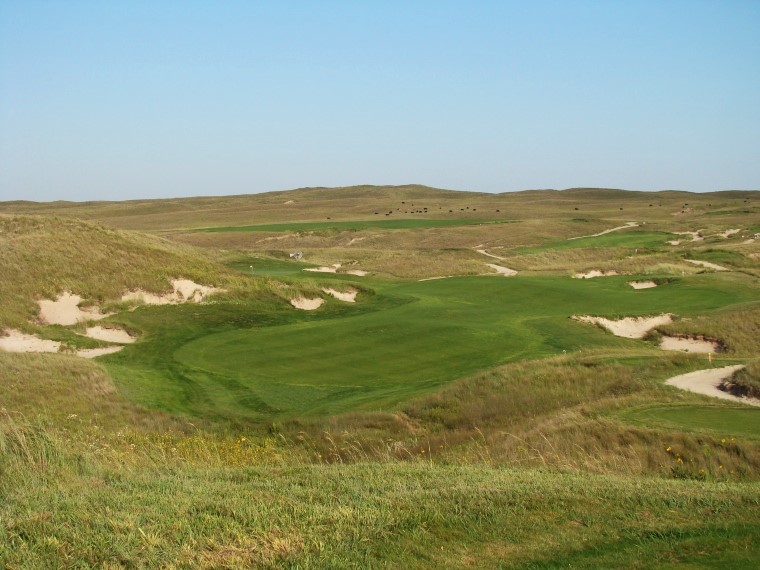
From the commanding tee position all is revealed: a wide fairway that swings left around the shoulder of a hill and finishes at a punchbowl green.
Second hole, 410 yards; The White Course at Dismal River obliterates all preconceived notions that the golfer might have of Nicklaus Design. In his Feature Interview Nicklaus noted that he learned from Pete Dye that ‘golf is a far more pleasant game when played downhill’ yet here we encounter a daunting uphill tee shot to a blind landing area. However, this is the Sand Hills of Nebraska and a design without the occasional uphill tee ball would do a disservice to the landscape – and cheat the golfer of variety. Courses that test the golfer in every possible way are the most satisfying to play. So too are courses that make the golfer think. At the second, the golfer who flirts with the trouble down the right is rewarded with a view of the sunken green ahead. The less risk the golfer accepts off the tee, the progressively more difficult his second shot becomes. Only when they were imbuing holes with strategy did Nicklaus Design modify landforms to any meaningful degree. In this case, they reduced a corner of a hill so that the golfer down the right was afforded a good look at the green.

While the up and down topography always meant that the White Course would be a strenuous walk, the walking trails makes the trek reasonable. Above is the one at the second.

Since there is no prevailing wind at Dismal River the holes need to be elastic and play well downwind, upwind, or in a crosswind. This has been enabled by the creation of green entrances that accept all variety of shots. On the author’s first play in benign conditions this hole was a little flick down the hill with a 7 iron but the following day required a blind three wood approach! Fortunately, the open green accommodated both with equal aplomb.
Third hole, 145 yards; Dismal’s fiery group of one shot holes holds the key to a good round. Disaster lurks especially at the fifth and tenth where playing features can throw a fragile golfer off stride. In many ways, the third is the simplest – and maybe the best. It plays across low dunes to a natural plateau where Nicklaus Design created a front right puff in the putting surface and shallow depressions left and back to provide interesting hole locations without the appearance of the architect trying too hard.

When it first opened, the green sat on top a wall of sand. However, managing the flow of water from Nebraska’s famously powerful thunderstorms dictated extending turf down the front wall to prevent deep ruts from routinely reoccurring.

Both natural and uncompromising, the bunkers at Dismal River make the hazards on most courses look namby-pamby.
Fourth hole, 525 yards; Much of the first nine falls across dramatic, tumbling land forms. Yet, there can be too much of a good thing like copious amounts of chocolate from Zurich or barrels of beer from Trappist monks. Similarly in golf, sensory overload is a legitimate concern for an architect working in such an inspirational environment. This three-shotter represents a delightful change of pace and a quiet moment as its fairway occupies the longest expanse of flat (relatively speaking!) land on the course; no other stretch comes close. Yet, fascinatingly enough, the fourth remains one of the most visually striking holes, in part by the windmill incorporated into the hole.
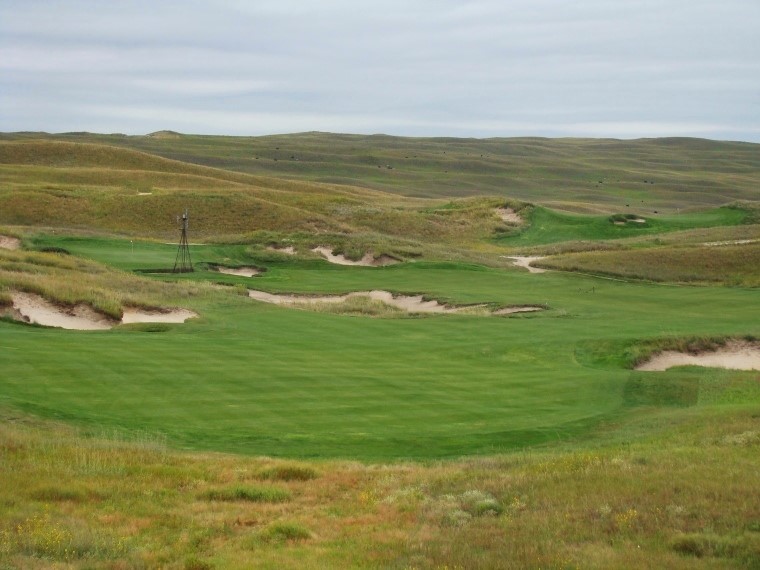
The ‘lovely valley’ that first captured Nicklaus’s attention became the fourth. All is laid before the golfer and Intelligent choices SHOULD be made. Yet, the sight of the flag to the left acts the siren, goading the golfer toward trouble.
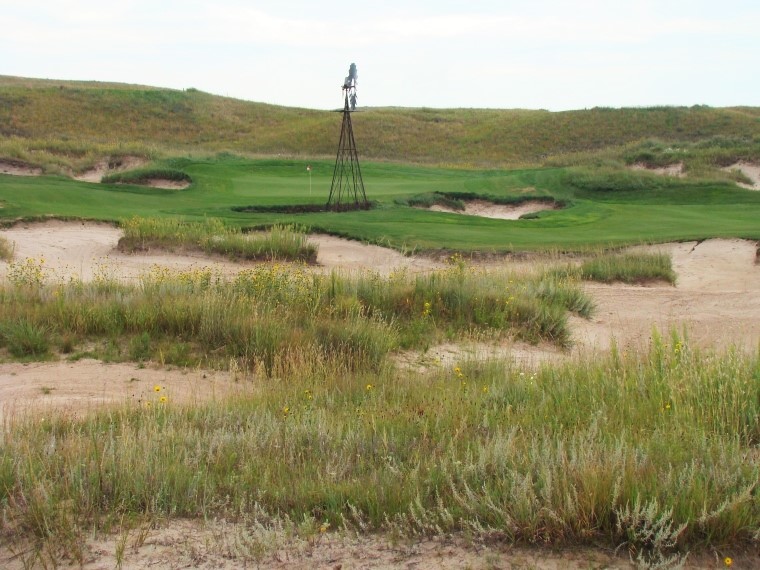
Under certain conditions, the fourth is reachable in two mighty blows but only by carrying this hazard and skirting past the windmill.
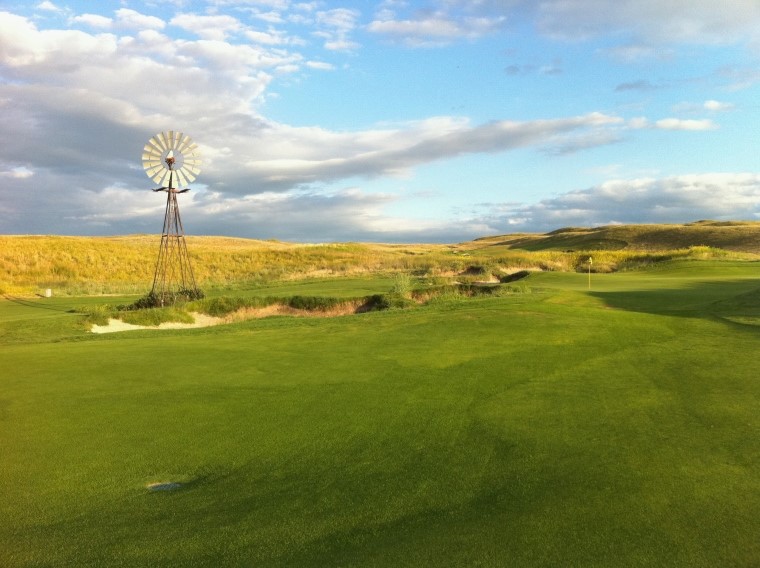
Nicklaus insisted that the working windmill stay put. In fact, the green’s orientation was carefully sculpted so that it is a mere forty yards from the front edge of the green. Its presence is amplified by front left hole locations.
Fifth hole, 140 yards; How inconvenient, here lies a low tee to a high, domed green in a windy environment. Few holes of this length cause such consternation. Indeed, the first time guest might fare better than the scared member, familiar with the hole’s terrors. Without doubt, the hole is easier into the wind than downwind when the firm-putting surface becomes sketchy to hold. The good player, even with only a short iron in his hands, won’t find the certainty of outcome he craves. The really good player knows how to appreciate a chip and putt par. According to Cochran, ‘The fifth is as pristine as any putting surface on the course. We removed maybe three inches of blown silt from the surface and the green was just there.’

The angled fifth green high in a saddle with false sides left and right requires an aerial shot into wind that blows with indifference. The green is sufficiently deep at 38 yards yet finding the putting surface is one of the more vexing tasks on a windy day.
Sixth hole, 305 yards; As noted early, this was a difficult hole to see in the routing process and it was the Great Man himself who found the depression high in the dunes that would serve as a natural punchbowl green. When given a special piece of property, Nicklaus Design responded with time honored, neat design features like punchbowl greens that aren’t prevalent across their other works. Most firms having done over 300 courses – as Nicklaus Design had done in 2005 – get stuck in their own beliefs and formulas. In short, they cease to invent. Not Nicklaus Design at Dismal River and it surely deserve both recognition and credit for adjusting its ‘style’ to such fun golf amid the sprawling hills.

A tee ball that carries 280 yards on a straight line from tee to green enjoys the chance of ending up in the punchbowl green.
Seventh hole, 435 yards; Though it’s laid over land that would stand out at most courses, the seventh melds into the fabric of the course as one of the more conventional holes. Max Behr’s “Line of Instinct,” a favorite design strategy of the author, is much on display at Dismal River. Like the first hole, the flag is visible in the distance with deep bunkers between the elevated tee and green.
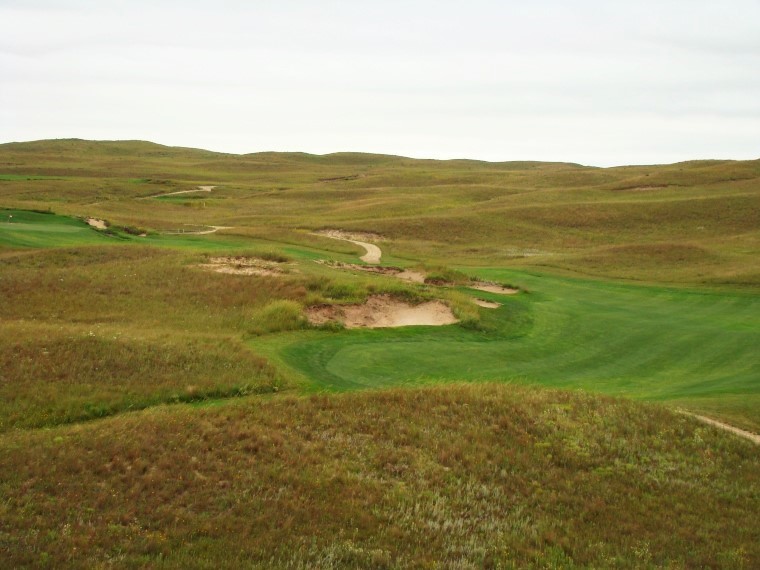
This switchback hole asks for a draw off the tee and a fade into the green. The fluttering flag to the left, like a fishing lure, helps reel in the unsuspecting prey. However, stray right off the tee and the approach becomes a 200 yard plus uphill bear.
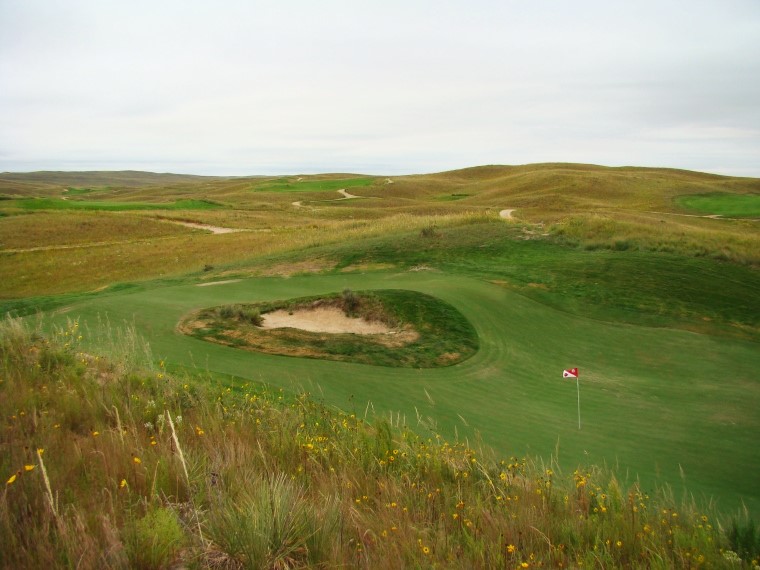
As seen from high right behind the green, the 57 yard deep green at the tenth affords all sorts of hole locations.
Eighth hole, 295 yards; A favorite design ploy of Nicklaus Design is the placement of a large hazard on a diagonal line from the tee with the fairway placed opposite (in this case the left) to the green. Countless playing options exist, ranging from a lay up in the fairway with a mid-iron to a slash at the green with a driver. As at the author’s other favorite Nicklaus course (Cabo del Sol in Mexico), the holes at Dismal River rotate from being very good to great with nary a weak one in the bunch. The eighth is one of the great ones. It is both reachable off the tee and drivable as well, meaning that the green complex will actually hold a tee ball from a mere mortal (a.k.a. a single digit handicap golfer). Tee balls along the boldest route are shunted onto the putting surface from high right off a dune. The annoying chance for a one putt eagle truly exists, which agitates good players to no end. Seeing the tee ball carry the shoulder of hill that hides the putting surface leaves the golfer with a most pleasurable walk wondering what sight will greet him at the green. One GolfClubAtlas.com regular even holed out here for a double eagle!
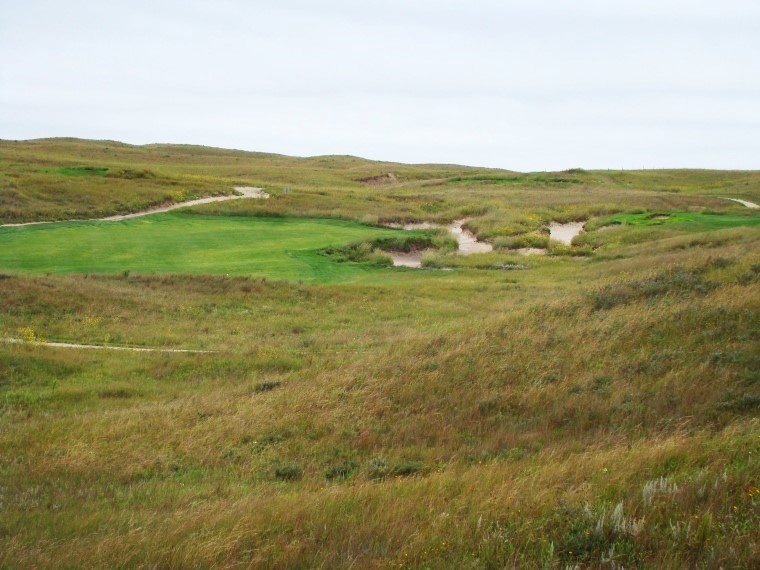
The wide fairway invites a prudent lay-up but … the nagging temptation to drive right toward the green creates delusions of grandeur!
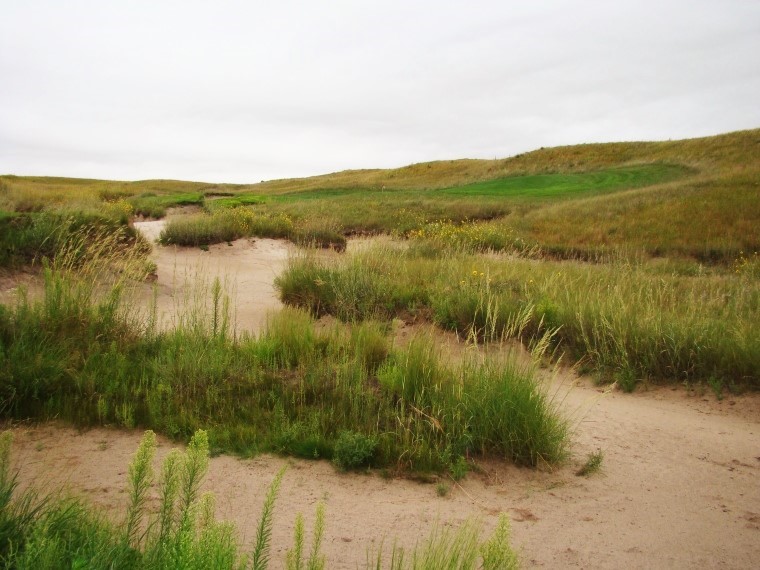
The eighth gets its teeth from one of the game’s most daunting hazards, a 110 yard bunker with enough deep nooks and crannies to hide four golfers from one another.
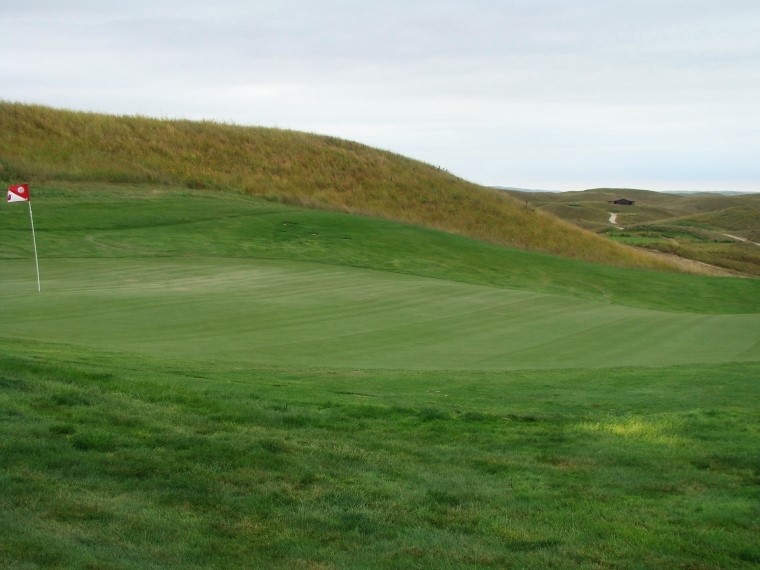
Simple from behind – the green, the hill that obscures it and the tee (underneath Jack’s Shack in the far distance).
Ninth hole, 590 yards; Dismal River’s par fives run in opposite directions on each side, a huge design plus for a windy site. If all the par fives played into the wind, the golfer’s ‘will’ would undoubtedly be sapped. As it is, the superlative routing ensures that each par five plays entirely different from the others. Visually, the ninth stands out as it features the widest fairway laid across the course’s broadest slope. A central hazard complicates matters but it is the unique manner in which the fairway falls across the canted land that lends the hole its own distinctive playing qualities.
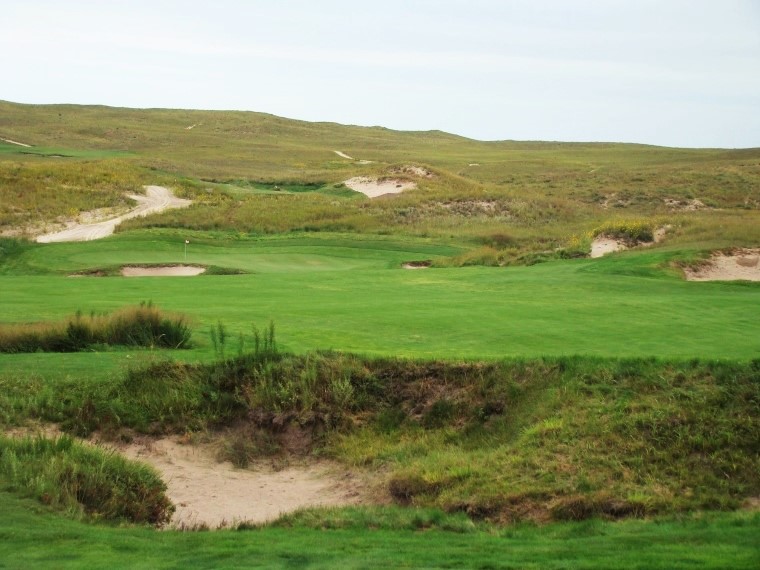
A version of Hell’s Bunker punctuates the fairway 230 yards from the green. Getting past it in two is vital, and doing so begins with a good tee ball.
Tenth hole, 160 yards; People whine when their favorite architects slip into a pattern of repeating themselves. However, should the architect try something out of the box, they whine more! What’s an architect to do? Taking design chances is important and especially in remote Nebraska, where all members must make a concerted effort just to get there. Some might argue (especially those who haven’t been to that temple of design, Riviera!) that it is hokey to have a bunker surrounded by green. In this case, the exposed sand already existed in front of a natural hollow for the green site. Cochran found it early on and it was Nicklaus who extended the green forward and wrapped the putting surface around the bunker. The resultant front left and right hole locations shorten the hole ~30 yards from the more traditional back hole locations. Given the diminished distance when played to either front hole location, the author readily accepts this unusual design. Hard to complain too vociferously when a short iron is in your hand!

As seen from high right behind the green, the 57 yard deep green at the tenth affords all sorts of hole locations.
Eleventh hole, 400 yards; Traversing landforms of all manner possible is what separates great designs (e.g. Royal County Down) from good ones (e.g. Royal Birkdale). Case in point is this hole where the golfer drives up and over the crest of a hill. Other holes on this side (twelfth, fourteenth, sixteenth, seventeenth, and eighteenth) play into attractive bowls and valleys so finding a hole to play across a valley – rather than in it – was important to a successful routing. The bunker on the far hillside must be carried if the golfer wishes to enjoy an open approach to the green.

… the golfer is treated to grand downhill approach shots. Nicklaus’s words about preferring his ‘landing area above my green’ ring true.
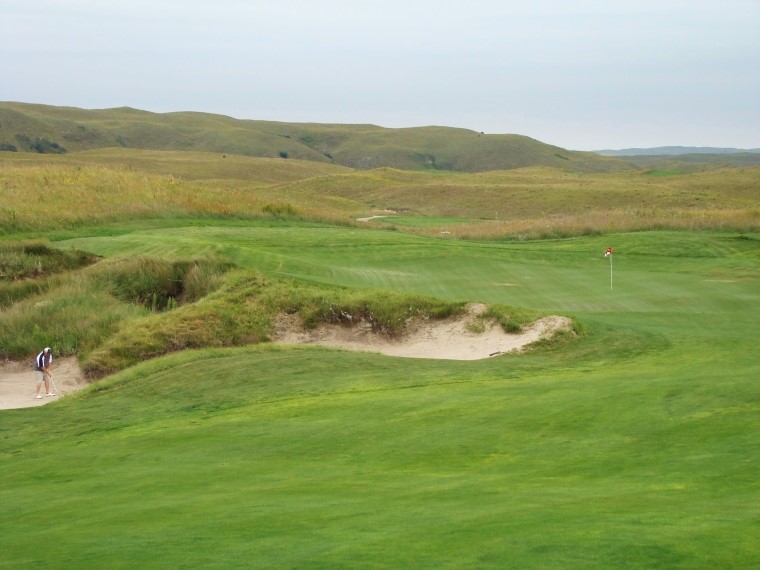
Note how puny the golfer appears. The scale of the hazards is in keeping with the vastness of the surrounds. The design features 62 bunkers but it can feel like more as they are invariably well positioned.

The putting surface at the eleventh highlights the intelligent evolution of the greens on the White Course. Initially, it was much bolder and featured a sharp left to right cant. Today’s green is more nuanced, and offers many more varied – and interesting – hole locations.
Twelfth hole, 535 yards; This free flowing hole exemplifies the lack of linear lines throughout the course. Its fairway shrugs right then left before finishing at a green angled to the fairway. The axis of the long green rewards the golfer who progresses his first two shots some ~450 yards up the fairway.

On this beautifully twisting hole the golfer who gets tangled up on either of his first two shots is hugely disadvantaged. Conversely, two good shots and the golfer enjoys a good look down the length of the green. Note the day’s vicious back right hole location.
Thirteenth hole, 380 yards; Why the White Course isn’t widely celebrated as Nicklaus’s best design in the United States is a mystery. Certainly, it was unsurpassed property and no allowance had to be made for housing. Yet, the course unexplainably has fared poorly in the magazine rankings. Course critics (especially those who write much better than they play) voiced harsh words early on. Perhaps panelists remember only the early version when, for instance, this 475 yard brute required a blind approach of some 200 yards over a dune. For the author, the original hole sounds like a winner (!) along the lines of 13 at Rye Golf Club or 14 at Royal West Norfolk. The rub is that it was followed by the course’s hardest hole and in sequence the pair overwhelmed most golfers. In 2010, the thirteenth green was pulled forward, transforming this hole into an attractive medium two-shotter. The incoming nine remains longer but this conversion to a sub-400 yarder makes it more manageable, varied and most importantly, fun.

Reasonable people disagree about how to tackle the thirteenth. Some prefer the high right side as it puts them on the same level as the green for their approach. Others …

…. head left of the central fairway bunker to approach the green head on. Only 18 paces deep, the green is the narrowest target on the property. Similar to the fourteenth at Muirfield Village, underestimate this modest length hole at your peril.
Fourteenth hole, 440 yards; All architects seemingly parrot the same, “We are sensitive to nature, we follow nature’s lead,” etc. etc. blah blah blah. How can you tell when it is true? Stand on this tee and you’ll know. Why? This bruiser is visually intimidating and yet the golfer is given precious little view of the fairway. In another place with a different set of circumstances the author believes that Nicklaus Design would have altered the land to provide better optics. Most golfers would consider that ‘fair’ as this is the longest par 4 on the course. In actuality, the fairway is bowled and plays quite wide as it runs down its own valley. Yet, the first timer is likely disconcerted on the tee and this visual intimidation is just another challenge that the good golfer needs to overcome for a successful round. It follows Alister MacKenzie’s time-honored concept of making a hole look harder than it plays so that the golfer can leave with a sense of heightened accomplishment.

Placed directly on top of the biggest and steepest greenside slope, the fourteenth green complex is both daunting and handsome. Importantly, it functions well for all golfers courtesy of the copious amount of short grass left of the green – no need exists to ever visit the deepest hazard on the property!
Fifteenth hole, 160 yards; Fans of C.B. Macdonald and Seth Raynor will be delighted when they step on the tee and soak in this modified Redan. Here the strategy is clear (at least in most winds) – hit a draw that utilizes the green’s right to left slopes to feed the ball toward the day’s hole location. On the very next hole, the golfer might not even be afforded the sight of the flag! The best designs alternate between visuals that entice and visuals that confuse. In that manner, they remain fresh to play, time and time again.

At the highest level, golf is a ground game and watching the ball roll slowly right to left across this putting surface is one of the round’s joys.
Sixteenth hole, 385 yards; A superb hole at every level. First, the tee is placed at a diagonal to the fairway. Second, the hole runs through an irregular valley where shoulders of short and long hills extend well into the fairway. Third, a fronting left bunker is perfectly cut into a hill thirty yards shy of the green, making some left hole locations blind. The tension between the short left greenside bunker and the two scar bunkers high on the short hill right off the tee provide this natural hole its enduring merit.

The flag becomes invisible for the golfer who is 20 yards left in the fairway, precisely where the less risky line from the tee leaves him.

As seen from behind, the putting surface gracefully cascades from front left to back right. Considered by some to be overwrought initially, the greens at Dismal River as they exist today are praiseworthy.
Seventeenth hole, 415 yards; The quip that Nicklaus built holes that only he could play (i.e. shots that favored a high fade) was rendered rubbish over two decades ago. Indeed, a penetrating draw is oft times the preferred shape at Dismal River, highlighted at this corker of a hole. The fairway is generous, over fifty yards wide, unless the golfer becomes greedy and tries to fit his tee ball within 150 yards or less of the green where the fairway narrows in half.
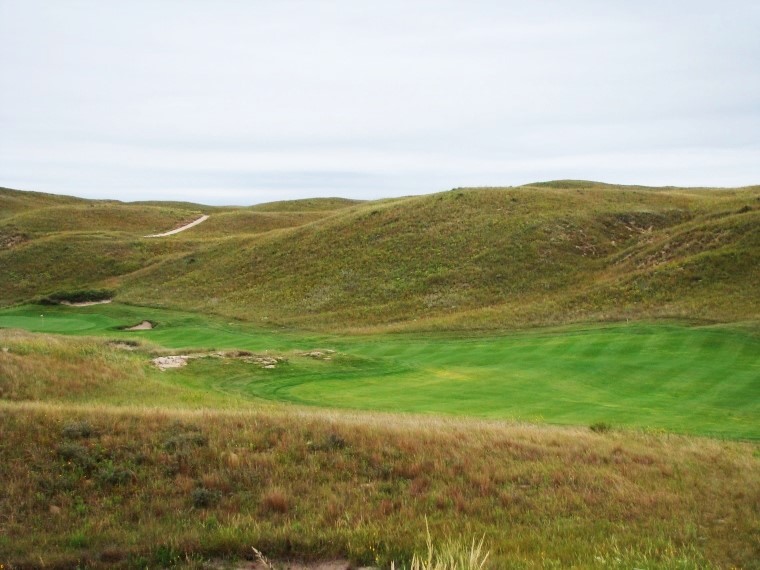
A bullet draw that follows the graceful bend of the fairway and then tumbles down into its narrow neck is a shot of great beauty and one that lingers in the mind long after.
Eighteenth hole, 505 yards; The author’s favorite type of finishing hole is a half par hole on the easy side. Be it the Home hole at St. Andrews, Pebble Beach, Castle Stuart or Cabot Cliffs, such holes leave the golfer wanting more – not less! In 2006 eighteen was a half par on the hard side. In fairness to Nicklaus Design, Nicklaus always intended the low tee just off the seventeenth green for regular play but over time, a high tee (as in 100 feet (!) higher in elevation and only reached by cart) became the more popular. Though sharply downhill, the hole played longer than Nicklaus originally envisaged from the upper tee. After Chris Johnson acquired Dismal River in 2009, he brought Nicklaus Design in to review the bully finisher. Wisely, the green was pulled forward ~60 yards. Triples can still be had, but so too can eagles and flocks of birdies.
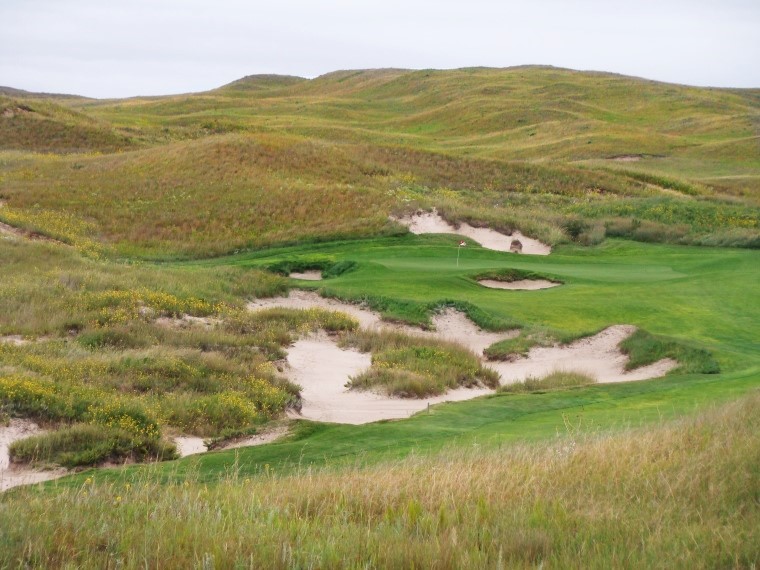
Nearly 200 yards in length, the largest hazard on the course hugs the left side of the eighteenth fairway and provides a distinctive exclamation point upon which to end the course. Much of the sandy blow out was there and this natural attribute leaves for shame the contrived features found on so many made for television modern courses.
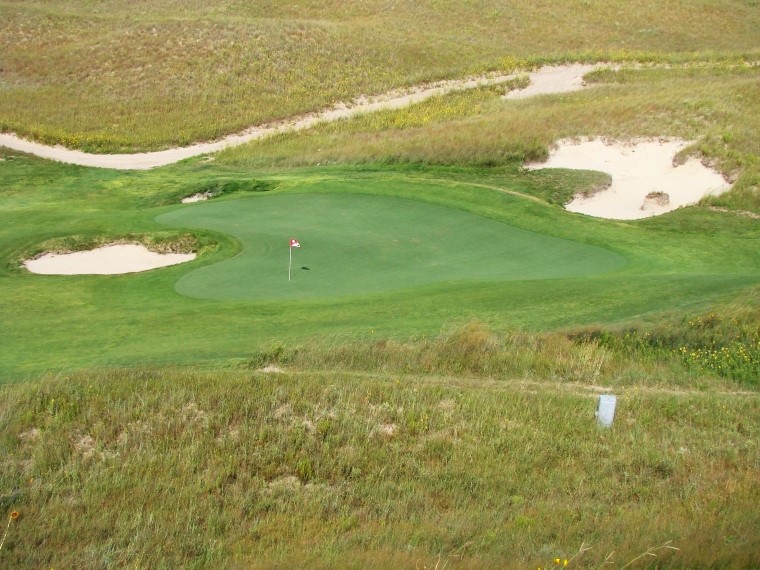
As seen from high above on the right, holes positioned in front are tough to approach, especially downwind. A false front is just a few paces from this hole location, yet above the flag is three putt territory on the sharply sloped green. Finesse, as opposed to brute power, now plays a crucial role in the final outcome.
Great sites for golf come along rarely, and when they do, they offer great opportunity and great peril. Should the architect come up short and not produce a course of lasting merit, he most surely fails the property, the owner and his profession. So it is, but the rare modern architect blessed with great land accepts such risk in the firm belief that he will triumph by creating something extraordinary – that’s exactly what happened here, if not at first then surely within its scant first few years.
Even better for the members, those rolling dunes and the area near the Dismal River that Nicklaus Design eschewed for the chance to work in the choppier stuff was made into a course by Tom Doak and his team in 2013. Since the two sites are wildly different (Doak’s more graceful, Nicklaus’ more rugged), so are the courses. Indeed, this author has never seen two courses at a private club so different and yet so complimentary to their respective sites. Though no ocean is present, the luxury of two entirely different top-drawer courses is hard to match.
The End


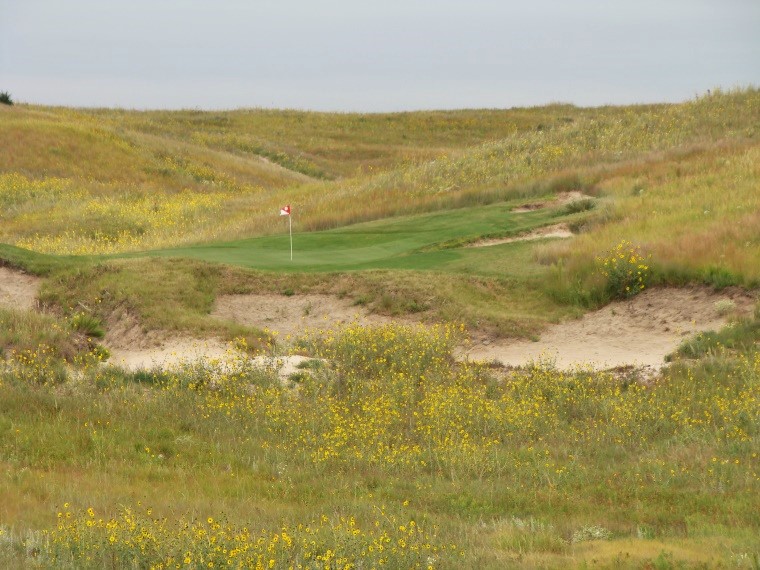



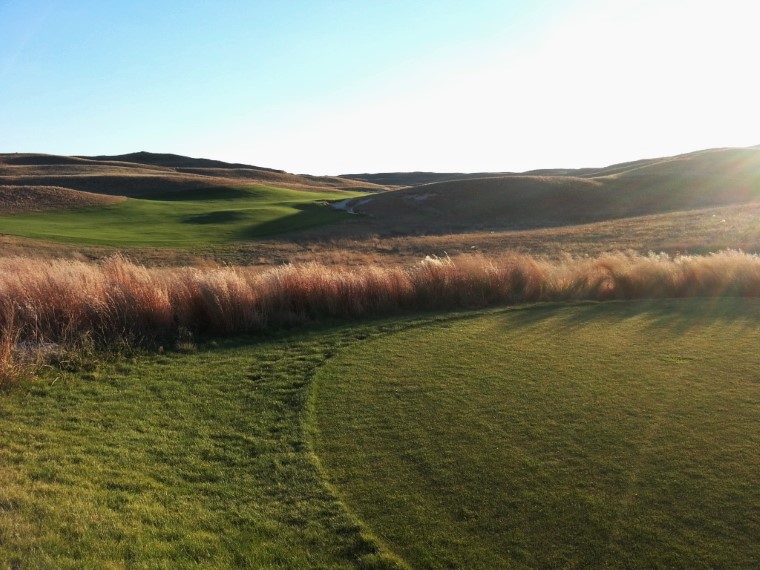
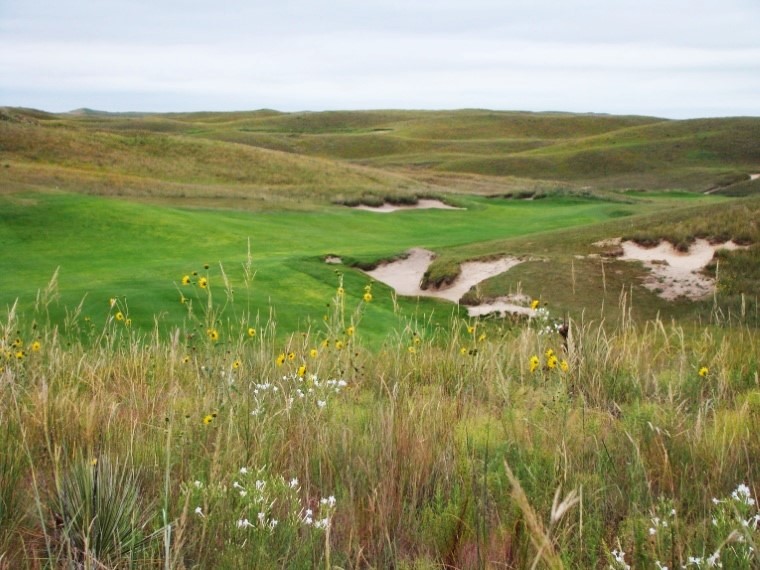




![The Park, West Palm (Lit 9) [2023]](https://golfclubatlas.com/wp-content/uploads/2024/12/IMG_7092-2-scaled-500x383.jpg)


